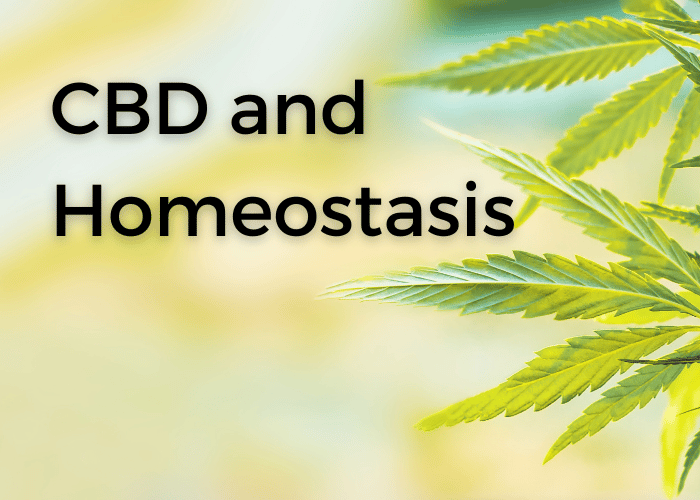No products added!
CBD and Homeostasis
Homeostasis is a term that refers to an automatic process an organism performs in order to regulate its internal stability in contrast to the ever-changing conditions of the external environment the organism is a part of.
Many systems in the body work together to maintain the steady and stable environment required for humans to live and function optimally. If these physical and chemical processes are disrupted, it could lead to serious and undesirable outcomes, like disease and organ failure.


Some processes that are self-regulated in the body as part of maintaining homeostasis are fluid levels, body temperature, acidity and alkalinity (pH balance). The body and its organ systems take queues from your nervous system to activate and adjust chemical and physiological reactions that are required to stay in balance. Labor contractions, blood clotting and body temperature regulation are just a few examples of homeostatic activities in the body.
So, how does CBD play a role in assisting the body in maintaining homeostasis? It all actually starts with the Endocannabinoid System (ECS.) All mammals, anything with a vertebrate, share a network of receptors that lay on the surface of cells throughout the body. These receptors are known as cannabinoid 1 (CB1) and cannabinoid 2 (CB2) receptors.
Over the past few decades, our understanding of the ECS has grown through medical studies, pre-clinical and observational studies. Though more research, studies and clinical trials are needed, what we know now is that the ECS is the master conductor in controlling homeostasis in the body because it sends messages to all organ systems in the body, and each organ system plays certain roles in working together to maintain the equilibrium our bodies require to perform regular daily functions.
The ECS also interacts with your central nervous system (CNS,) glands and hormone production via the endocrine system, and several other chemical and physiological aspects in the body. Besides regulating organ systems and communication throughout the body, the ECS regulates mood, sleep, appetite, sex drive, cognition, pain perception, digestion, energy production, stress response etc…


Our bodies produce cannabinoids similar to the cannabinoids found in cannabis plants. These cannabinoids are referred to as endogenous cannabinoids because they come from inside the body – the term, endo, means “inside.” Examples of endogenous cannabinoids are anandamide and 2-AG.
The cannabinoids from cannabis are called phytocannabinoids because they come from plants, and “phyto” is the Greek word for plants, hence they are plant cannabinoids. Since CBD interacts directly and indirectly with the CB1 and CB2 receptors throughout the body, it has the ability to assist the ECS in maintaining equilibrium in the body.
How us humans manage stress is very important to our overall health and well-being. If stress becomes uncontrollable or chronic, our bodies can literally break down, and a host of unwanted physiological and psychological side effects can occur, think chronic anxiety or PTSD. An example of how CBD is used to help the ECS maintain equilibrium in the body can be seen in the role it plays in balancing the HPA Axis.
HPA stands for Hypothalamic, Pituitary and Adrenal, and these glands are critical for managing stress levels in the body. The HPA Axis and the ECS work together to regulate stress. Unlike its psychoactive cousin, THC, which has an affinity to CB1 receptors and combines with them the way a key fits into a lock, the non-psychoactive CBD interacts with other cells indirectly, and influences the way the ECS interacts with various receptors and neurotransmitters in the body.
CBD inhibits the production of two enzymes, MAGL and FAAH, which break down two of the most important endocannabinoids in the body, anandamide and 2-AG. Studies have shown that people with low levels of anandamide and 2-AG in the body often present with chronic or acute stress or anxiety, so there is a direct correlation between the amount of these two endogenous cannabinoids in the body and one’s ability to manage stress. The higher the levels of these two cannabinoids, the healthier a person’s response to stress will be.
As CBD slows down the production of MAGL and FAAH which breaks down cannabinoids in the body, it allows for increased levels of anandamide and 2-AG. Anandamide has been shown to be important in the production of serotonin in the body, and serotonin plays an important role in balancing mood and energy levels. I apologize if this is getting too technical, so allow me to express this in simpler terms. Most adults know about the “fight-or-flight” response in the body.
When we perceive a threat to ourselves (real or imagined) our body responds physiologically by activating the HPA axis to produce hormones that allow our body to respond; accordingly, however, if this process is activated too often, it can lead to a physiological and psychological breakdown. Therefore, it is so important to manage your stress and to seek help if you are unable to control your stress levels.
CBD is not a silver bullet, and it will not cure chronic or acute stress, but it can help to support the ECS in its role to maintain homeostasis by allowing the ECS to function more effectively to improve the overall health and well-being of people who may be experiencing an overload of stress.
There are several other ways that CBD can help to maintain balance within the body. The example of how it impacts the ECS and the HPA Axis process is just one way that CBD can be beneficial to us.

